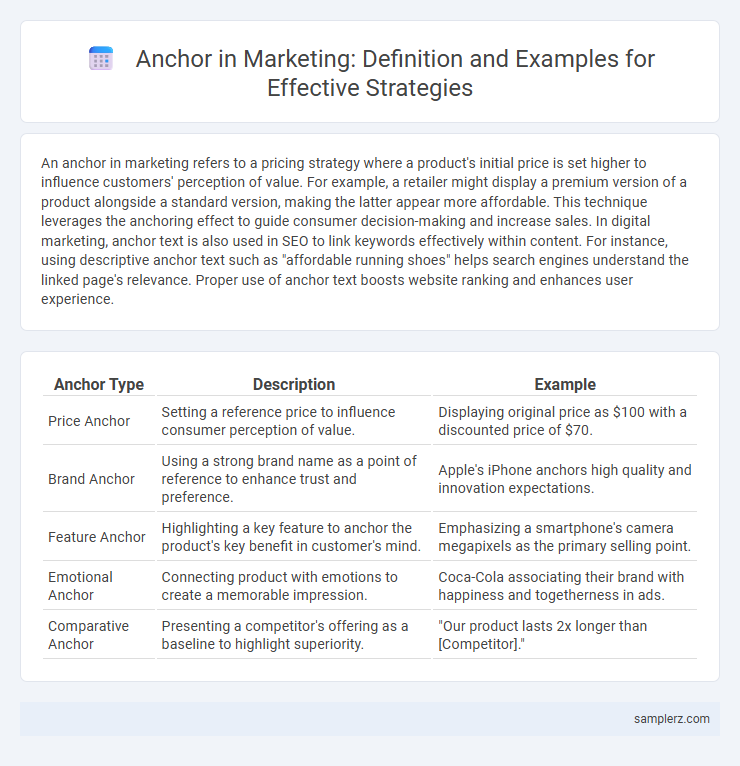An anchor in marketing refers to a pricing strategy where a product's initial price is set higher to influence customers' perception of value. For example, a retailer might display a premium version of a product alongside a standard version, making the latter appear more affordable. This technique leverages the anchoring effect to guide consumer decision-making and increase sales. In digital marketing, anchor text is also used in SEO to link keywords effectively within content. For instance, using descriptive anchor text such as "affordable running shoes" helps search engines understand the linked page's relevance. Proper use of anchor text boosts website ranking and enhances user experience.
Table of Comparison
| Anchor Type | Description | Example |
|---|---|---|
| Price Anchor | Setting a reference price to influence consumer perception of value. | Displaying original price as $100 with a discounted price of $70. |
| Brand Anchor | Using a strong brand name as a point of reference to enhance trust and preference. | Apple's iPhone anchors high quality and innovation expectations. |
| Feature Anchor | Highlighting a key feature to anchor the product's key benefit in customer's mind. | Emphasizing a smartphone's camera megapixels as the primary selling point. |
| Emotional Anchor | Connecting product with emotions to create a memorable impression. | Coca-Cola associating their brand with happiness and togetherness in ads. |
| Comparative Anchor | Presenting a competitor's offering as a baseline to highlight superiority. | "Our product lasts 2x longer than [Competitor]." |
Understanding the Concept of Anchoring in Marketing
Anchoring in marketing refers to the cognitive bias where consumers rely heavily on the first piece of information they receive when making decisions, such as the initial price shown for a product. For example, a retailer might display a high original price next to a discounted price, making the sale seem more attractive and encouraging purchases. This strategy leverages perceived value by setting a reference point that influences customer perception and buying behavior.
Classic Examples of Pricing Anchors in Retail
Classic examples of pricing anchors in retail include the use of a high-priced item placed next to standard products to influence consumer perception of value. For instance, luxury watches displayed alongside mid-range models create a reference point that makes the latter appear more affordable. Retailers also commonly use "original price vs. sale price" tags to establish an anchor, highlighting perceived savings and motivating purchase decisions.
How Brands Use Anchoring to Influence Perceived Value
Brands utilize anchoring by presenting a high initial price to set consumer expectations, making subsequent offers appear more attractive and valuable. Luxury brands often display premium products alongside mid-range options to elevate the perceived worth of the latter. This psychological tactic significantly influences purchase decisions by manipulating perceived value through strategic price positioning.
The Role of Anchoring in Product Bundling
Anchoring in product bundling strategically sets a reference price that influences consumer perception of value, making bundled offers appear more attractive compared to individual purchases. By presenting a high-priced item alongside lower-priced products, marketers create a price anchor that increases the perceived savings and enhances purchase intention. Effective anchoring leverages consumer psychology to boost bundle sales and improve overall revenue.
Anchoring Strategies in E-Commerce Platforms
Anchoring strategies in e-commerce platforms often involve presenting a higher-priced item first to create a reference point that makes subsequent products appear more affordable. For instance, displaying a premium smartphone model alongside mid-range options encourages consumers to perceive mid-tier devices as better value for money. This psychological pricing technique increases average order value and enhances purchase decisions by leveraging comparative price assessment.
Psychological Triggers: Anchoring Effects on Consumer Decision-Making
Anchoring in marketing leverages initial price points or product features to influence consumer perception and decision-making, making subsequent options seem more attractive or reasonable. For example, displaying a high-priced item first sets a mental reference that anchors consumers' expectations, increasing the likelihood of choosing mid-range products. This psychological trigger exploits the anchoring effect, where initial information disproportionately impacts judgment, enhancing marketing strategies and sales outcomes.
Effective Anchoring in Digital Advertising Campaigns
Effective anchoring in digital advertising campaigns leverages price points or product comparisons to influence consumer perception and increase conversion rates. For example, displaying a premium product alongside a discounted option anchors customer expectations around value and affordability. Incorporating strategically placed anchor prices in ad creatives improves click-through rates and drives higher engagement by guiding consumer decision-making.
Anchoring Techniques in Subscription-Based Business Models
Subscription-based businesses often use price anchoring techniques by presenting a high-priced premium plan first to make standard and basic plans appear more affordable and appealing. Offering limited-time introductory rates or trial periods serves as an anchor to reduce perceived risk and encourage sign-ups. Displaying the savings from annual plans compared to monthly payments creates a value anchor that drives customers toward longer commitments.
Comparative Anchors: Using Competitor Pricing to Your Advantage
Comparative anchors in marketing leverage competitor pricing as a strategic tool to influence consumer perception of value and affordability. By prominently displaying a higher competitor price alongside your own, customers perceive your offer as more attractive and budget-friendly, enhancing conversion rates. This technique capitalizes on cognitive biases, such as the anchoring effect, to position products favorably within a competitive landscape and drive sales growth.
Real-World Case Studies of Anchoring Success in Marketing
In marketing, anchor pricing has driven significant sales boosts, exemplified by Amazon's strategy of listing original prices alongside discounted offers, creating a perceived value that encourages purchases. Another real-world instance is Apple's pricing of the iPhone, where the premium model sets a high anchor, making mid-tier versions appear more affordable and attractive. These case studies demonstrate how effectively leveraging anchoring bias influences consumer decision-making and enhances revenue.

example of anchor in marketing Infographic
 samplerz.com
samplerz.com